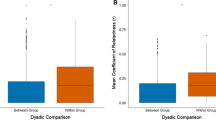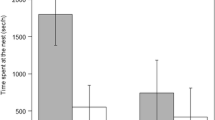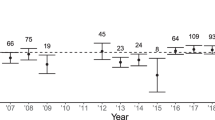Abstract
While extensive empirical and theoretical work has focused on the evolution of costly cooperation (particularly in group-living species), less attention has been paid to more low-risk or immediately beneficial forms of cooperation. In some non-group-living darters, alloparental care (or allocare) by subordinates has been noted to result from by-product benefits as small territorial (subordinate) males adopt and provide care to the abandoned eggs of large territorial (dominant) males. In the tessellated darter (Etheostoma olmstedi), allocare also results from sneak fertilization. However, information on the rate of allocare by tessellated darters is contradictory: prior behavioral work suggested that it is very common, while a genetic examination showed males to primarily care for their own young. We found behavioral and genetic evidence of very high levels of allocare at our study location. The relative size of the assigned fathers of young to the alloparental male is consistent with the idea that initial allocare primarily results from sneak fertilization (“cuckoldry-based allocare”), but later allocare results from subordinate males caring at previously abandoned nests (“adoption-based allocare”). Larger males appeared to breed more frequently at different nests, but did not father more individual offspring than smaller males. Finally, low relatedness between abandoning and alloparenting males suggests that kin selection does not contribute to alloparental care. We discuss how variation in nest availability may explain the inconsistent findings of the rate of alloparental care in the tessellated darter, and how increased research in this and similar systems can expand our understanding of the evolution of cooperation.


Similar content being viewed by others
References
Balshine S, Buston PM (2008) Cooperation in fish. In: Magnhagen C, Braithwaite V, Forsgren E, Kapoor BG (eds) Fish behaviour ecology. Science Publishers, Inc, Enfield, USA pp 437–484
Beneteau CL, Mandrak NE, Heath DD (2007) Characterization of eight polymorphic microsatellite DNA markers for the greenside darter, Etheostoma blennioides (Percidae). Mol Ecol Notes 7:641–643
Bergmüller R, Johnstone RA, Russell AF, Bshary R (2007) Integrating cooperative breeding into theoretical concepts of cooperation. Behav Process 76:61–72
Bessert ML, Brozek J, Orti G (2007) Impact of nest substrate limitations of patterns of illegitimacy in the fathead minnow, Pimephales promelas (Cypriniformes: Cyprinidae). J Hered 98:716–722
Boomsma JJ (2007) Kin selection versus sexual selection: why the ends do not meet. Curr Biol 17:R673–R683
Bukacinski D, Bukacinski M, Lubjuhn T (2000) Adoption of chicks and the level of relatedness in common gull, Larus canus, colonies: DNA fingerprinting analyses. Anim Behav 59:289–299
Buston PM, Balshine S (2007) Cooperating in the face of uncertainty: a consistent framework for understanding the evolution of cooperation. Behav Process 76:152–159
Clutton-Brock T (2002) Breeding together: kin selection and mutualism in cooperative vertebrates. Science 296:69–72
Clutton-Brock T (2009) Cooperation between non-kin in animal societies. Nature 462:51–57
Connor RC (1995) Altruism among non-relatives: alternative to the ‘Prisoner’s Dilemma’. Trends Ecol Evol 10:84–86
Connor R (2007) Invested, extracted and byproduct benefits: a modified scheme for the evolution of cooperation. Behav Process 76:109–113
Conrad KF, Clarke MF, Robertson RJ, Boag PT (1998) Paternity and the relatedness of helpers in the cooperatively breeding bell miner. Condor 100:343–349
Constantz GD (1979) Social dynamics and parental care in the tessellated darter (Pisces: Percidae). Proc Acad Nat Sci Phil 313:131–138
Constantz GD (1985) Allopaternal care in the tessellated darter, Etheostoma olmstedi (Pisces: Percidae). Env Biol Fish 14:175–183
DeWoody JA, Fletcher DE, Wilkins SD, Avise JC (2000) Parentage and nest guarding in the tessellated darter (Etheostoma olmstedi) assayed by microsatellite markers (Perciformes: Percidae). Copeia 2000:740–747
DeWoody JA, Fletcher DE, Wilkins SD, Avise JC (2001) Genetic documentation of filial cannibalism in nature. P Natl Acad Sci USA 98:5090–5092
DuVal EH (2007) Adaptive advantages of cooperative courtship for subordinate male lance tailed manakins. Am Nat 169:423–432
Eberle M, Kappeler PM (2006) Family insurance: kin selection and cooperative breeding in a solitary primate (Microcebus murinus). Behav Ecol Sociobiol 60:582–588
Emlen ST (1991) Adaptive versus nonadaptive explanations of behavior: the case of alloparental helping. Am Nat 138:259–270
Farmer MB, Alonzo SH (2008) Competition for territories does not explain allopaternal care in the tessellated darter. Env Biol Fish 83:391–395
Fisher HS, Hoekstra HE (2010) Competition drives cooperation among closely related sperm of deer mice. Nature 463:801–803
Frank SA (2003) Repression of competition and the evolution of cooperation. Evolution 57:693–705
Gabel JM, Dakin EE, Freeman BJ, Porter BA (2007) Isolation and identification of eight microsatellite loci in the Cherokee darter (Etheostoma scotti) and their variability in other members of the general Etheostoma, Ammocyrpta, and Percina. Mol Ecol Notes 8:149–151
Gale WF, Deutsch WG (1985) Fecundity and spawning frequency of captive tessellated darters—fractional spawners. T Am Fish Soc 114:220–229
Green WW, Mirza RS, Pyle GG (2008) Kin recognition and cannibalistic behaviours by adult male fathead minnows (Pimephales promelas). Naturwissenschaften 95:269–272
Griffin AS, West SA (2003) Kin discrimination and the benefit of helping in cooperatively breeding vertebrates. Science 302:634–636
Hain TJA, Neff BD (2009) Kinship affects innate responses to a predator in bluegill Lepomis macrochirus larvae. J Fish Biol 75:728–737
Hamilton WD (1963) The evolution of altruistic behaviour. Am Nat 97:354–356
Hamilton WD (1964a) The genetical evolution of social behaviour. I. J Theoret Biol 7:1–16
Hamilton WD (1964b) The genetical evolution of social behaviour. II. J Theoret Biol 7:17–52
Hatchwell BJ, Komdeur J (2000) Ecological constraints, life history traits and the evolution of cooperative breeding. Anim Behav 59:1079–1086
Hudman SP, Grose MJ, Landis JB, Skalski GT, Wiley EO (2008) Twenty-three microsatellite DNA loci for population genetic studies and parentage assignment in orangethroat darter, Etheostoma spectabile. Mol Ecol Res 8:1483–1485
Hughes WHO, Oldroyd BP, Beekman M, Ratnieks FLW (2008) Ancestral monogamy shows kin selection is the key to the evolution of eusociality. Science 320:1213–1216
Jadwiszczak P (2009) Rundom Pro 3.14. Software for classical and computer-intensive statistics available free from the New Rundom Site (http://pjadw.tripod.com). Accessed July 2009
Jones O, Wang J (2009) COLONY: a program for parentage and sibship inference from multilocus genotype data. Mol Ecol Res 10:551–555
Kalinowski ST, Taper ML, Marshall TC (2007) Revising how the computer program CERVUS accommodates genotyping error increases success in paternity assignment. Mol Ecol 16:1099–1106
Krakauer AH (2005) Kin selection and cooperative courtship in wild turkeys. Nature 434:69–72
Lyon BE, Eadie JMcA (2008) Conspecific brood parasitism in birds: a life-history perspective. Annu Rev Ecol Evol Syst 39:343–363
McDonald DB, Potts WK (1994) Cooperative display and relatedness among males in a lek mating bird. Science 266:1030–1032
Nastase AJ, Sherry DA (1997) Effect of brood mixing on location and survivorship of juvenile Canada geese. Anim Behav 54:503–507
Neff BD (2003) Paternity and condition affect cannibalistic behavior in nest-tending bluegill sunfish. Behav Ecol Sociobiol 54:377–384
Packer C, Gilbert DA, Pusey AE, O’Brien SJ (1991) A molecular genetic analysis of kinship and cooperation in African lions. Nature 351:562–565
Page LM (1983) Handbook of darters. TFH, Neptune City
Pennisi E (2005) How did cooperative behavior evolve? Science 309:93
Pizzari T, Foster KR (2008) Sperm sociality: cooperation, altruism, and spite. PLOS Biol 6:925–931
Porter BA, Fiumera AC, Avise JC (2002) Egg mimicry and alloparental care: two mate-attracting tactics by which nesting striped darter (Etheostoma virgatum) males enhance reproductive success. Behav Ecol Sociobiol 51:350–359
Solomon NG, French JF (1997) Cooperative breeding in mammals. Cambridge University Press, Cambridge
Stiver KA, Alonzo SH (2009) Parental and mating effort: is there necessarily a trade-off? Ethology 115:1101–1126
Stiver KA, Alonzo SH (2010) Large males have a mating advantage in a species of darter with smaller, alloparental males, Etheostoma olmstedi. Curr Zool 56:1–5
Stiver KA, Alonzo SH (2011) Alloparental care increases mating success. Behav Ecol 22:206–211. doi:10.1093/beheco/arq186
Tonnis BD (2006) Microsatellite DNA markers for the rainbow darter, Etheostoma caeruleum (Percidae), and their potential utility for other darter species. Mol Ecol Notes 6:230–232
Unger LM, Sargent RC (1988) Alloparental care in the fathead minnow, Pimephales promelas: females prefer males with eggs. Behav Ecol Sociobiol 23:27–32
Wang J (2011) COANCESTRY: a program for simulating, estimating and analysing relatedness and inbreeding coefficients. Mol Ecol Res 11:141–145
Winn HE (1958) Comparative reproductive behavior and ecology of fourteen species of darter (Pisces-Percidae). Ecol Monogr 28:155–191
Wisenden BD (1999) Alloparental care in fishes. Rev Fish Biol Fisheries 9:45–70
Acknowledgments
The research was conducted with the permission and cooperation of Stephen Gephard and the Connecticut Department of Environmental Protection (Inland Fisheries Division). We are grateful to Dr. T.J. Near for his assistance and support and Drs. DE Fletcher and JA DeWoody for information on individual and nest density at their tessellated darter study site. Funding was provided by Yale University, by a grant from the National Science Foundation (IOB-0450807) to S.H.A., and by a Natural Sciences and Engineering Research Council of Canada (NSERC) Postdoctoral Fellowship to K.A.S.
Ethical standards
This study conforms to all laws of the United States of America. It was conducted under the ethics guidelines of Yale University (Institutional Animal Care and Use Committee Protocol #2008-10908), and with the permission of the Connecticut Department of Environmental Protection, Inland Fisheries Division (scientific collecting permit number SC-08002).
Conflict of interest
The authors declare that they have no conflict of interest.
Author information
Authors and Affiliations
Corresponding author
Additional information
Communicated by J. Lindström
Electronic supplementary material
Below is the link to the electronic supplementary material.
ESM 1
(PDF 197 kb)
Rights and permissions
About this article
Cite this article
Stiver, K.A., Wolff, S.H. & Alonzo, S.H. Adoption and cuckoldry lead to alloparental care in the tessellated darter (Etheostoma olmstedi), a non-group-living species with no evidence of nest site limitation. Behav Ecol Sociobiol 66, 855–864 (2012). https://doi.org/10.1007/s00265-012-1334-3
Received:
Revised:
Accepted:
Published:
Issue Date:
DOI: https://doi.org/10.1007/s00265-012-1334-3




